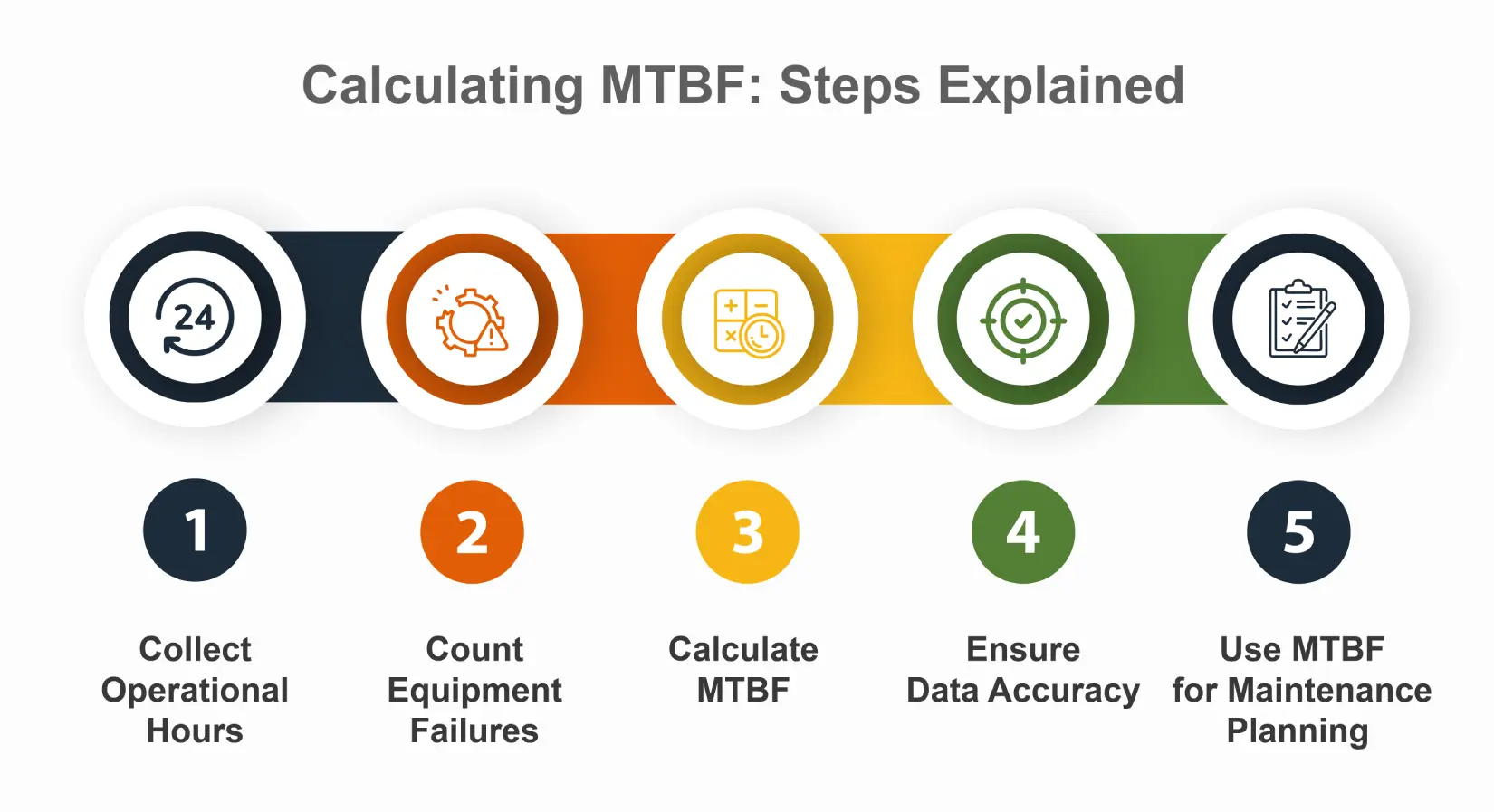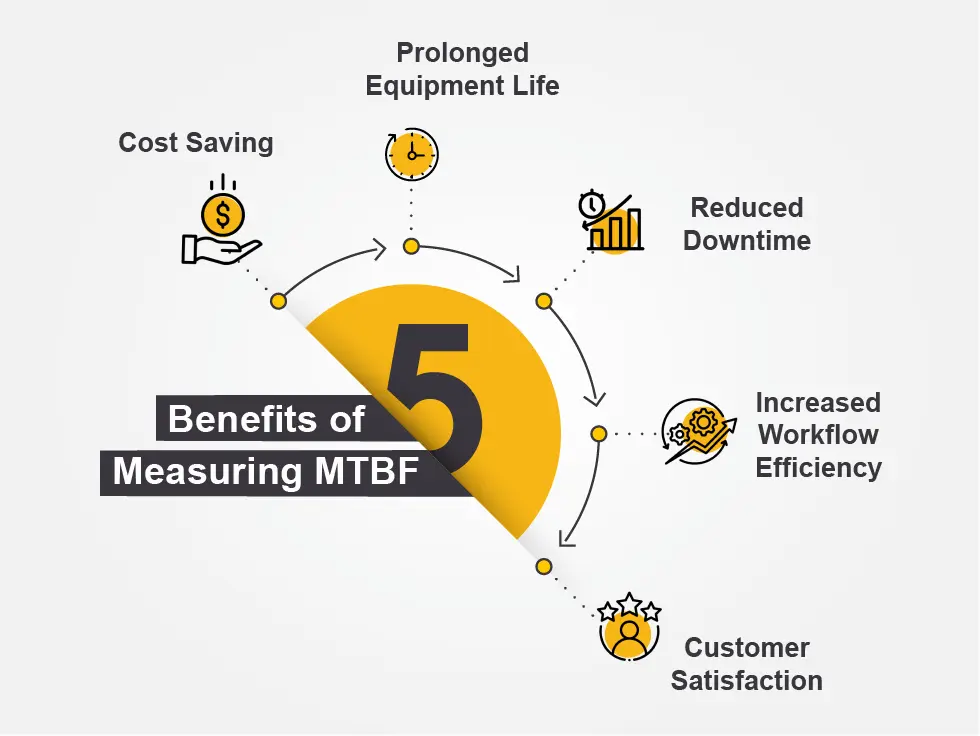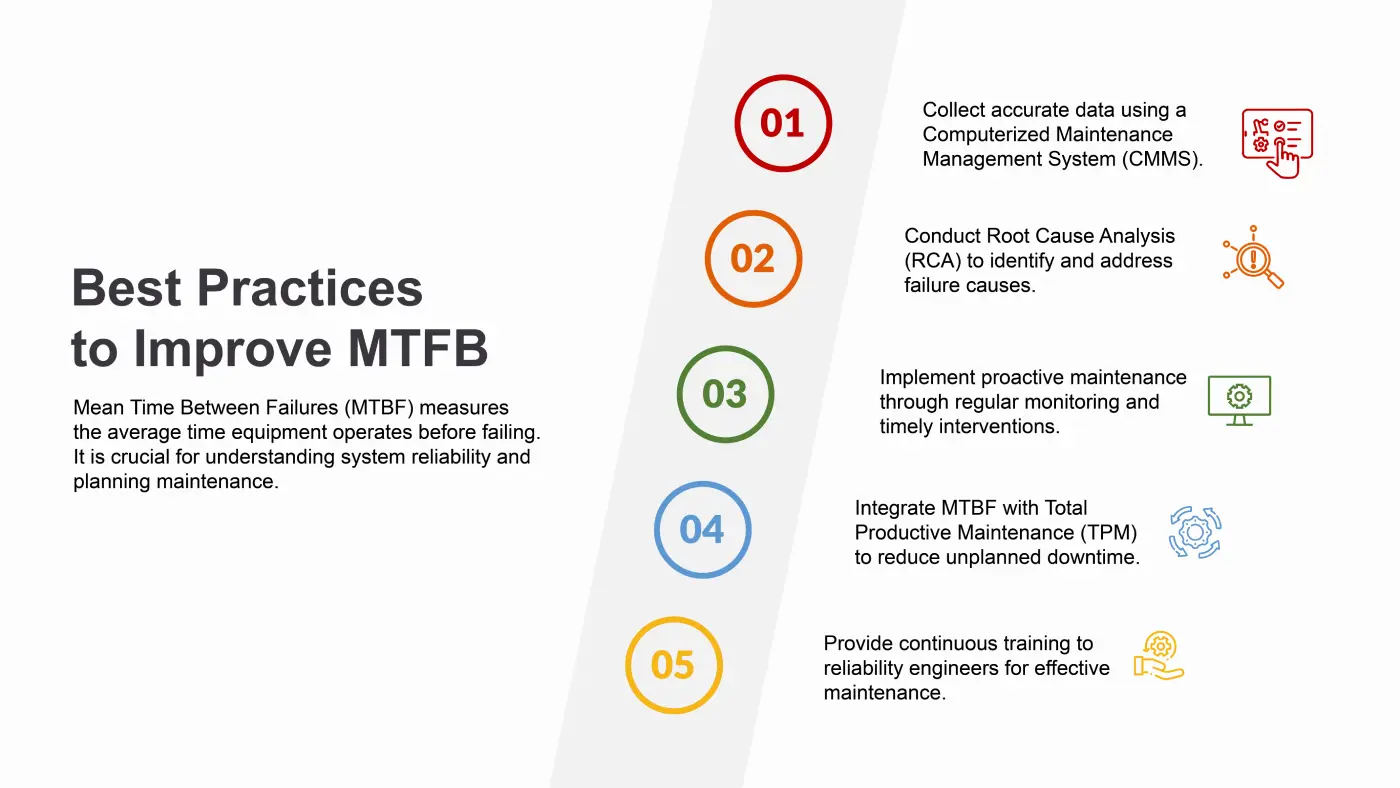Mean Time Between Failures (MTBF) measures the average time equipment operates before failing. It is crucial for understanding system reliability and planning maintenance. This article explains what MTBF is, its importance, how to calculate it, and its applications across industries.
Understanding Mean Time Between Failures (MTBF)
Mean Time Between Failures (MTBF) is a key metric that measures the average time equipment operates between failures. Typically expressed in hours, MTBF provides a snapshot of how long a system can run before encountering an issue. It indicates the reliability of systems and assets, providing valuable insights into their operational lifespan and performance under normal conditions.
The primary purpose of calculating MTBF is to gather insights from equipment failures, which can then be used to enhance maintenance strategies and mitigate the impact of these failures. Meticulous tracking of equipment failures and maintenance activities allows businesses to optimize maintenance practices, reduce unplanned downtime, and enhance overall reliability. A higher MTBF indicates greater reliability, suggesting that systems are likely to function longer before experiencing a failure.
MTBF stands out as a critical metric for understanding system reliability and anticipating failures. It provides a clear picture of an asset’s useful lifespan and expected operational reliability, making it a valuable tool for maintenance teams and reliability engineers. Focusing on the average operational time before a failure occurs, the mtbf value helps organizations prioritize maintenance efforts and keep their equipment in optimal condition.
The Importance of MTBF in Maintenance Management
In maintenance management, MTBF is a key metric for enhancing system reliability and reducing downtime. A higher MTBF indicates a lower likelihood of failure, which directly benefits productivity by allowing for better planning and scheduling of maintenance activities. Reliability engineers and maintenance managers rely on MTBF calculations to develop effective maintenance schedules and manage spare parts inventory more efficiently.
MTBF is instrumental in planning preventive maintenance schedules by identifying patterns in equipment failures. Understanding the typical time between failures allows businesses to schedule maintenance tasks at optimal intervals, avoiding unnecessary tasks and ensuring timely interventions. This not only extends the lifespan of assets but also improves productivity by reducing unplanned downtime.
- Methods for securing the enterprise network
- Indispensable SOC tools
- Common obstacles to a streamlined

Moreover, improving MTBF has significant implications for overall maintenance management. It helps maintenance teams avoid unnecessary interventions, reducing maintenance costs and enhancing asset performance. MTBF insights support better maintenance strategies and practices, ultimately leading to higher productivity and fewer operational disruptions.
How to Calculate MTBF: Step-by-Step Guide

- Step 1: Collect Operational Hours:
Gather the total operational hours of the equipment. If the equipment has been used across multiple periods, sum all the operational hours to get the total. - Step 2: Count Equipment Failures:
Record the number of failures that occurred during the same period. Ensure this data is accurate and reflects all breakdowns or malfunctions. - Step 3: Calculate MTBF:
Use the following formula:

- Step 4: Ensure Data Accuracy:
For precise calculations, avoid relying on estimates. Maintain detailed records of operational hours and failure occurrences to improve the reliability of your MTBF calculations. - Step 5: Use MTBF for Maintenance Planning:
Accurate MTBF values help develop effective maintenance strategies and enhance equipment reliability by identifying patterns and predicting future failures.
MTBF Calculation Formula Explained
The MTBF formula is a simple yet powerful tool for calculating the reliability of systems. It is given by the formula: MTBF = Total operating time / Number of failures. This formula provides a clear measure of how long a system can operate before experiencing a failure. The components of the MTBF formula include the total uptime of the equipment and the number of breakdowns that occurred during this time.
One important aspect to consider is censoring, which refers to the underestimation of MTBF by excluding the runtimes of systems that have not yet failed. To achieve an accurate MTBF measure, account for all relevant data by accurately recording the total operating time and number of failures.
Real-World Example of MTBF Calculation
Consider a real-world example to illustrate the MTBF calculation. Suppose a motor operates for a total of 2,080 hours and experiences 4 failures during this period. Using the MTBF formula, we calculate the MTBF as 2,080 hours divided by 4 failures, resulting in an MTBF of 520 hours. This indicates that, on average, the motor operates for 520 hours before encountering a failure.
In another scenario, a mechanical mixer that breaks down twice in 10 days has an MTBF of 46.5 hours, while a pump that runs for 1,000 hours with four breakdowns has an MTBF of 250 hours.
These examples show how MTBF reflects the average operational time between breakdowns, offering valuable insights into system reliability.
Benefits of Measuring MTBF

Measuring MTBF offers numerous benefits that can significantly impact maintenance management and overall productivity. One of the primary advantages is cost savings. Accurately tracking MTBF helps businesses reduce unplanned maintenance interventions, leading to significant cost savings. Extending MTBF often results in prolonged equipment life, which in turn reduces capital expenditures required for replacing equipment.
Reliable equipment with higher MTBF helps maintain efficient workflows, reducing downtime and increasing output efficiency. Improvements in MTBF also enhance customer satisfaction by minimizing downtime and ensuring consistent product quality.
In safety-critical sectors like aerospace and healthcare, improved MTBF can significantly lower the risk of accidents, ensuring safer operations and better-quality control processes.
- What data has been potentially exposed?
- Incursion detection and Persistence detection
- How should I respond?

Challenges in Calculating MTBF
Despite its benefits, calculating MTBF presents several challenges.
- The accuracy of MTBF calculations heavily relies on the quality and availability of failure data and operating time records. Poor quality or lack of data on failures and operating time can hinder the accuracy of MTBF calculations, leading to unreliable results.
- Additionally, changes in operational conditions, such as temperature and humidity, can make consistent MTBF calculations difficult. Variability in maintenance practices, whether excessive or insufficient, can also skew MTBF results.
- In complex systems with many components, pinpointing the exact source of failure can complicate the calculation of MTBF. Accurate data collection and consideration of all relevant factors are crucial when calculating MTBF.
Comparing MTBF with Related Metrics
MTBF is closely related to several other maintenance metrics, each providing unique insights into system performance and reliability. Understanding how MTBF interacts with metrics like Mean Time to Repair (MTTR) and Mean Time to Failure (MTTF) is key to developing effective maintenance strategies. While MTBF focuses on the average time between failures, MTTR measures the time taken to restore a system after a failure, while MTTF indicates the expected lifespan of non-repairable components.
External factors such as operating times, environmental conditions, and usage patterns can influence these metrics, affecting overall equipment reliability. Considering these interactions helps businesses understand their systems’ performance comprehensively and develop more effective maintenance practices.
Mean Time to Repair (MTTR)
Mean Time to Repair (MTTR) is a crucial maintenance metric that measures the duration required to repair or restore an asset after a failure. It represents the average time taken to bring a component back to operational status, providing insights into the effectiveness of maintenance programs. A lower MTTR indicates that repairs are performed efficiently, minimizing downtime and enhancing overall reliability.
The condition of an asset can significantly impact MTTR, as aging equipment often requires longer repair times. Tracking MTTR allows businesses to assess maintenance team performance and identify areas for improvement in repair processes. This, in turn, contributes to better maintenance strategies and improved system reliability.
Mean Time to Failure (MTTF)
Mean Time to Failure (MTTF) is another important metric that applies to non-repairable components and systems. Unlike MTBF, which focuses on repairable systems, MTTF measures the expected lifespan before a failure occurs, indicating the maximum hours of service for non-repairable items.
MTTF is only applicable for components that require total replacement once they fail. Understanding MTTF helps businesses plan timely replacements, avoiding unexpected shutdowns and ensuring continuous operation and reliability.
Failure Rate
Failure rate is a critical metric that provides insights into the reliability of systems by expressing the number of failures over a given period. It is calculated as the number of failures divided by the total time of operation, offering a clear picture of how frequently failures occur. The inverse of MTBF, failure rate helps identify trends and patterns in system performance, allowing for proactive maintenance interventions.
Failure rate is not directly related to uptime or operational availability. This contrasts with MTBF, which does have a correlation with those factors. However, it serves as an early warning system for potential issues, enabling businesses to address problems before they lead to costly downtime and system breakdowns.
Monitoring failure rates helps organizations improve maintenance strategies and enhance overall system reliability.
Improving MTBF: Best Practices

Improving MTBF requires a combination of accurate data collection, proactive maintenance strategies, and continuous training. Accurate data collection is the first step, achievable using a Computerized Maintenance Management System (CMMS). A CMMS serves as a centralized repository for operational data, ensuring that records are maintained correctly and consistently.
Conducting Root Cause Analysis (RCA) helps uncover the underlying reasons behind equipment failures, leading to preventive strategies that can significantly improve MTBF. Proactive maintenance strategies, such as regular condition monitoring and timely interventions, play a crucial role in enhancing reliability.
Additionally, integrating MTBF with Total Productive Maintenance (TPM) principles allows for pattern identification and preventive maintenance, reducing unplanned downtime. Continuous training for reliability engineers ensures that they are equipped to identify issues and perform maintenance correctly, further improving MTBF.
Application of MTBF Across Industries
MTBF is a versatile metric used across various industries to enhance reliability and optimize maintenance practices. In the automotive sector, for example, MTBF is critical for evaluating the durability of vital parts such as engines and transmissions. Understanding the time between failures allows manufacturers to design more reliable vehicles and plan maintenance schedules to minimize downtime.
In the aerospace industry, MTBF plays a vital role due to the critical safety implications of equipment failures. Ensuring that aircraft systems have a high MTBF is essential for maintaining safety and reliability standards.
Similarly, in the life sciences field, MTBF helps ensure that laboratory instruments and medical devices are reliable, reducing the risk of operational failures that could impact research outcomes and patient safety. Across all these sectors, tracking and improving MTBF is fundamental to maintaining high performance and reliability of systems.
Conclusion
Understanding and leveraging MTBF is crucial for maintaining and improving the reliability of systems across various industries. By accurately calculating MTBF, businesses can gather valuable insights into equipment performance, optimize maintenance strategies, and reduce unplanned downtime. The benefits of measuring MTBF extend beyond cost savings, contributing to enhanced workflows, better customer satisfaction, and improved safety.
As we have explored, MTBF is not without its challenges, particularly concerning accurate data collection and the influence of external factors. However, by adopting best practices such as proactive maintenance, Root Cause Analysis, and continuous training, organizations can significantly improve their MTBF metrics. Embracing these practices will lead to more reliable systems, longer equipment lifespans, and ultimately, a more efficient and productive operation.
Frequently Ask Questions
What is MTBF, and why is it important?
MTBF, or Mean Time Between Failures, is a critical metric that assesses the average operational interval between equipment failures. Its importance lies in its ability to enhance system reliability and improve maintenance strategies, thereby minimizing downtime.
How do you calculate MTBF?
To calculate MTBF, divide the total operational hours by the number of failures, using the formula MTBF = Total operating time / Number of failures. This straightforward calculation provides valuable insights into the reliability of a system.
What are the benefits of measuring MTBF?
Measuring MTBF provides substantial benefits, including cost savings, prolonged equipment life, improved workflows, enhanced customer satisfaction, and increased safety and quality control. Employing this metric is essential for optimizing operational efficiency.
What challenges are associated with calculating MTBF?
Calculating MTBF is challenging due to the necessity of precise failure data, the impact of varying operational conditions, differences in maintenance practices, and the complexity inherent in multi-component systems. Addressing these factors is crucial for obtaining reliable MTBF metrics.
How can businesses improve their MTBF?
To improve MTBF, businesses should focus on accurate data collection, conduct Root Cause Analysis, implement proactive maintenance strategies, align with Total Productive Maintenance principles, and ensure continuous training for reliability engineers. This comprehensive approach will enhance overall reliability and performance.



